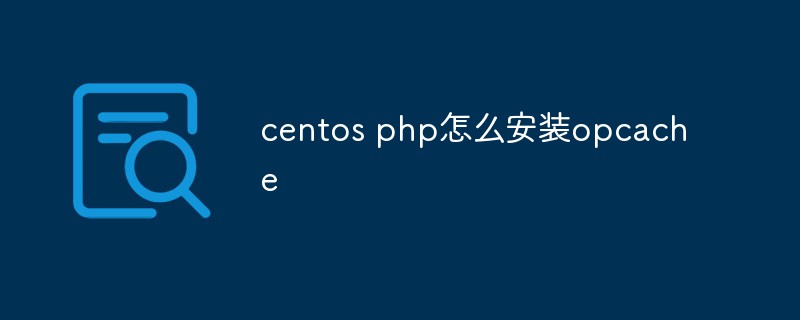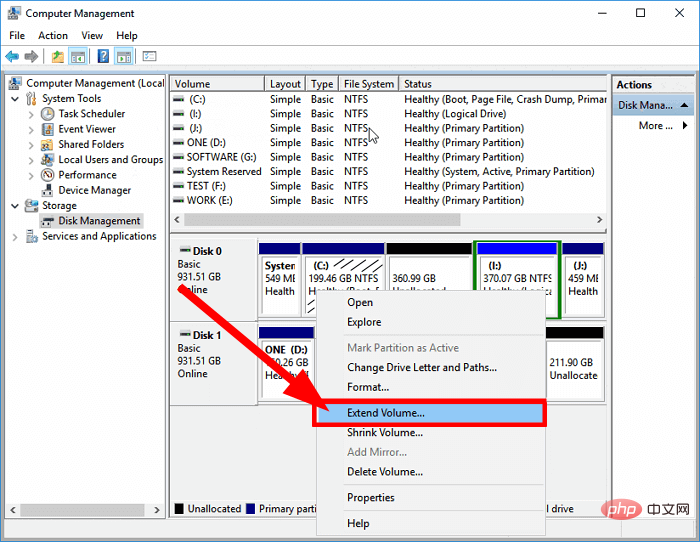 php教程
php教程 php手册
php手册 Compilation and installation of PHP7 under CentOS, MySQL support and solutions to some problems
Compilation and installation of PHP7 under CentOS, MySQL support and solutions to some problemsI recently tried php7 and encountered some problems in compiling and supporting MySQL. I believe many students have encountered the same problem, so I will talk about the process here. To put it simply, there are only 3 steps to compile PHP7: 1. ./buildconf --force 2. ./configure 3. make make install Steps 1 and 3 are nothing to worry about. Configure is the key to compilation and involves
I recently tried php7 and encountered some problems in compiling and supporting MySQL. I believe many students have encountered the same problem, so I will talk about the process here. Simply speaking, compiling PHP7 only requires 3 steps:
1. ./buildconf --force
2. ./configure
3. make && make install
There is nothing to worry about in steps 1 and 3. Configure is the key to compilation and involves PHP’s support for some libraries. Here we use the minimum support, including MySQL:
curl
gd
fpm
mysqlnd
The reason why we use curl and gd as examples is to make it clear that these third-party libraries must be installed before compiling PHP. You can directly use yum to install them in the default location, or you can compile and install them to a specified location. After yum is installed, , there is no need to specify the installation location of the library when compiling. You can search for a lot about installing these libraries. Let’s take a look at the basic configure
./configure --PRefix=/apps/php/php7.<span style="color: #800080;">0</span> --enable-mbstring --with-curl --with-gd --with-config-<span style="color: #0000ff;">file</span>-path=/apps/php/php7.<span style="color: #800080;">0</span>/etc/ --enable-fpm --enable-mysqlnd --with-pdo-mysql=mysqlnd
PHP-FPM
Regarding fpm, I believe it goes without saying that using it to support PHP is a better choice. PHP5.3.3 has built-in php-fpm, so of course it is also available in PHP7. You only need to --enable-fpm. That’s it
php-fpm parameters:
--start Start
--stop force termination
--quit smooth termination
--restart Restart
--reload smoothly reloads php’s php.ini
--logrotate Re-enable log file
MySQL support
I’ll focus on this, because I spent a little time on it, and I don’t know which version it started from. PHP no longer wants to use the mysql library to support mysql connections. It has enabled mysqlnd to support it. I heard it is faster than libmysql. Many, PHP5.x can also use libmysql. PHP7 seems to have canceled the support. The --with-mysql parameter is not available in compilation. Only --with-mysqli and --with-pdo-mysql are supported. You can check the configure parameters. Come and find out:
./configure -help | <span style="color: #0000ff;">grep</span> mysql

As you can see, PHP hopes to use mysqlnd to support MySQL, so the parameters can be written like this:
--enable-mysqlnd
--with-mysqli=mysqlnd
--with-pdo-mysql=mysqlnd
mysqlnd does not require mysql support, so it can be compiled and passed without installing mysql first. Start php-fpm and check phpinfo. You can see that mysqlnd and pdo_mysql indicate that php can already support mysql (pdo is used here) , mysqli is the same)


A few questions
Compilation problem: cc: Internal error: Killed (program cc1)
This is the first time I encountered this problem. It turned out that my Alibaba Cloud server turned off swap and there was not enough memory, so I reported this error. The solution is very simple, just add the --disable-fileinfo parameter when configure.
PHP reported that the mysql service cannot be found
As it said, it was indeed not found. Take a look at the pdo_mysql.default_socket item in phpinfo

Where is mysql.sock? Let’s take a look at the real location of mysql.sock. Use the command: ps -ef|grep mysql to view:

Obviously not in the same location, my correct location is: /var/lib/mysql/mysql.sock
So, modify php.ini, find pdo_mysql.default_socket, change it to your actual location, and restart php-fpm. Unfortunately, although php.ini has this configuration, after modification, it does not work. It is best to compile When , specify the location of mysql.socket:
--with-mysql-sock=/var/lib/mysql/mysql.sock
If that still doesn’t work, you can create a soft link to mysql.sock in the /tmp directory:
<span style="color: #0000ff;">ln</span> -s /var/lib/mysql/mysql.sock mysql.sock
Restart php-fpm again, I believe it is running normally. If you need more libraries supported by PHP, you can compile again and add the required support when configure, which is --with-xxx. Remember that if it is a third-party library, you must install these libraries first.
 centos用什么命令可查版本号Mar 03, 2022 pm 06:10 PM
centos用什么命令可查版本号Mar 03, 2022 pm 06:10 PM查版本号的命令:1、“cat /etc/issue”或“cat /etc/redhat-release”,可输出centos版本号;2、“cat /proc/version”、“uname -a”或“uname -r”,可输出内核版本号。
 centos重启网卡的方法是什么Feb 22, 2023 pm 04:00 PM
centos重启网卡的方法是什么Feb 22, 2023 pm 04:00 PMcentos重启网卡的方法:1、对于centos6的网卡重启命令是“service network restart”;2、对于centos7的网卡重启命令是“systemctl restart network”。
 centos php怎么安装opcacheJan 19, 2023 am 09:50 AM
centos php怎么安装opcacheJan 19, 2023 am 09:50 AMcentos php安装opcache的方法:1、执行“yum list php73* | grep opcache”命令;2、通过“yum install php73-php-opcache.x86_64”安装opcache;3、使用“find / -name opcache.so”查找“opcache.so”的位置并将其移动到php的扩展目录即可。
 centos 怎么离线安装 mysqlFeb 15, 2023 am 09:56 AM
centos 怎么离线安装 mysqlFeb 15, 2023 am 09:56 AMcentos离线安装mysql的方法:1、将lib中的所有依赖上传到linux中,并用yum命令进行安装;2、解压MySQL并把文件复制到想要安装的目录;3、修改my.cnf配置文件;4、复制启动脚本到资源目录并修改启动脚本;5、将mysqld服务加入到系统服务里面;6、将mysql客户端配置到环境变量中,并使配置生效即可。
 centos 7安装不出现界面怎么办Jan 03, 2023 pm 05:33 PM
centos 7安装不出现界面怎么办Jan 03, 2023 pm 05:33 PMcentos7安装不出现界面的解决办法:1、选择“Install CentOS 7”,按“e”进入启动引导界面;2、 将“inst.stage2=hd:LABEL=CentOS\x207\x20x86_64”改为“linux dd”;3、重新进入“Install CentOS 7”,按“e”将“hd:”后的字符替换成“/dev/sdd4”,然后按“Ctrl+x”执行即可。
 centos 怎么删除 phpFeb 24, 2021 am 09:15 AM
centos 怎么删除 phpFeb 24, 2021 am 09:15 AMcentos删除php的方法:1、通过“#rpm -qa|grep php”命令查看全部php软件包;2、通过“rpm -e”命令卸载相应的依赖项;3、重新使用“php -v”命令查看版本信息即可。
 centos中ls命令不显示颜色怎么办Apr 20, 2022 pm 03:16 PM
centos中ls命令不显示颜色怎么办Apr 20, 2022 pm 03:16 PM方法:1、利用“vim ~/.bashrc”编辑用户目录(~)下的“.bashrc”文件;2、在文件内添加“alias ls="ls --color"”;3、利用“:wq!”命令保存文件内的更改;4、“exit”命令退出终端后重新连接即可。
 如何在 CentOS 9 Stream 上安装 NagiosMay 10, 2023 pm 07:58 PM
如何在 CentOS 9 Stream 上安装 NagiosMay 10, 2023 pm 07:58 PM我们的PC中有一个磁盘驱动器专门用于所有与Windows操作系统相关的安装。该驱动器通常是C驱动器。如果您还在PC的C盘上安装了最新的Windows11操作系统,那么所有系统更新(很可能是您安装的所有软件)都会将其所有文件存储在C盘中。因此,保持此驱动器没有垃圾文件并在C驱动器中拥有足够的存储空间变得非常重要,因为该驱动器拥有的空间越多,您的Windows11操作系统运行起来就越顺畅。但是您可以在磁盘驱动器上增加多少空间以及可以删除多少文件是有限制的。在这种情况下,


Hot AI Tools

Undresser.AI Undress
AI-powered app for creating realistic nude photos

AI Clothes Remover
Online AI tool for removing clothes from photos.

Undress AI Tool
Undress images for free

Clothoff.io
AI clothes remover

AI Hentai Generator
Generate AI Hentai for free.

Hot Article

Hot Tools

mPDF
mPDF is a PHP library that can generate PDF files from UTF-8 encoded HTML. The original author, Ian Back, wrote mPDF to output PDF files "on the fly" from his website and handle different languages. It is slower than original scripts like HTML2FPDF and produces larger files when using Unicode fonts, but supports CSS styles etc. and has a lot of enhancements. Supports almost all languages, including RTL (Arabic and Hebrew) and CJK (Chinese, Japanese and Korean). Supports nested block-level elements (such as P, DIV),

MantisBT
Mantis is an easy-to-deploy web-based defect tracking tool designed to aid in product defect tracking. It requires PHP, MySQL and a web server. Check out our demo and hosting services.

SAP NetWeaver Server Adapter for Eclipse
Integrate Eclipse with SAP NetWeaver application server.

Atom editor mac version download
The most popular open source editor

MinGW - Minimalist GNU for Windows
This project is in the process of being migrated to osdn.net/projects/mingw, you can continue to follow us there. MinGW: A native Windows port of the GNU Compiler Collection (GCC), freely distributable import libraries and header files for building native Windows applications; includes extensions to the MSVC runtime to support C99 functionality. All MinGW software can run on 64-bit Windows platforms.






